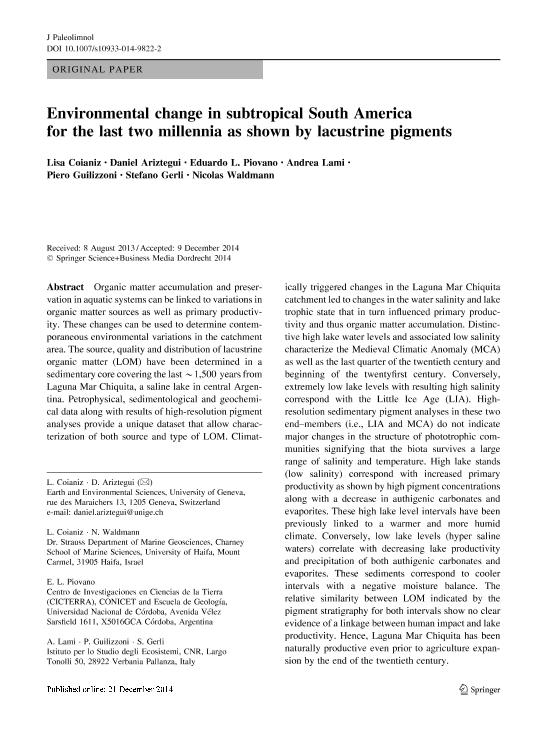Mostrar el registro sencillo del ítem
dc.contributor.author
Coianiz, Lisa
dc.contributor.author
Ariztegui, Daniel

dc.contributor.author
Piovano, Eduardo Luis

dc.contributor.author
Lami, Andrea
dc.contributor.author
Guilizzoni, Piero
dc.contributor.author
Gerli, Stefano
dc.contributor.author
Waldmann, Nicolas
dc.date.available
2021-06-14T15:44:13Z
dc.date.issued
2015-02
dc.identifier.citation
Coianiz, Lisa; Ariztegui, Daniel; Piovano, Eduardo Luis; Lami, Andrea; Guilizzoni, Piero; et al.; Environmental change in subtropical South America for the last two millennia as shown by lacustrine pigments; Springer; Journal Of Paleolimnology; 53; 2; 2-2015; 233-250
dc.identifier.issn
0921-2728
dc.identifier.uri
http://hdl.handle.net/11336/133802
dc.description.abstract
Organic matter accumulation and preservation in aquatic systems can be linked to variations in organic matter sources as well as primary productivity. These changes can be used to determine contemporaneous environmental variations in the catchment area. The source, quality and distribution of lacustrine organic matter (LOM) have been determined in a sedimentary core covering the last ~1,500 years from Laguna Mar Chiquita, a saline lake in central Argentina. Petrophysical, sedimentological and geochemical data along with results of high-resolution pigment analyses provide a unique dataset that allow characterization of both source and type of LOM. Climatically triggered changes in the Laguna Mar Chiquita catchment led to changes in the water salinity and lake trophic state that in turn influenced primary productivity and thus organic matter accumulation. Distinctive high lake water levels and associated low salinity characterize the Medieval Climatic Anomaly (MCA) as well as the last quarter of the twentieth century and beginning of the twentyfirst century. Conversely, extremely low lake levels with resulting high salinity correspond with the Little Ice Age (LIA). High-resolution sedimentary pigment analyses in these two end–members (i.e., LIA and MCA) do not indicate major changes in the structure of phototrophic communities signifying that the biota survives a large range of salinity and temperature. High lake stands (low salinity) correspond with increased primary productivity as shown by high pigment concentrations along with a decrease in authigenic carbonates and evaporites. These high lake level intervals have been previously linked to a warmer and more humid climate. Conversely, low lake levels (hyper saline waters) correlate with decreasing lake productivity and precipitation of both authigenic carbonates and evaporites. These sediments correspond to cooler intervals with a negative moisture balance. The relative similarity between LOM indicated by the pigment stratigraphy for both intervals show no clear evidence of a linkage between human impact and lake productivity. Hence, Laguna Mar Chiquita has been naturally productive even prior to agriculture expansion by the end of the twentieth century.
dc.format
application/pdf
dc.language.iso
eng
dc.publisher
Springer

dc.rights
info:eu-repo/semantics/openAccess
dc.rights.uri
https://creativecommons.org/licenses/by-nc-sa/2.5/ar/
dc.subject
CENTRAL ARGENTINA
dc.subject
FOSSIL PIGMENTS
dc.subject
HPLC
dc.subject
ORGANIC MATTER
dc.subject
SALINE LAKE
dc.subject
SUBTROPICAL SOUTH AMERICA
dc.subject.classification
Investigación Climatológica

dc.subject.classification
Ciencias de la Tierra y relacionadas con el Medio Ambiente

dc.subject.classification
CIENCIAS NATURALES Y EXACTAS

dc.title
Environmental change in subtropical South America for the last two millennia as shown by lacustrine pigments
dc.type
info:eu-repo/semantics/article
dc.type
info:ar-repo/semantics/artículo
dc.type
info:eu-repo/semantics/publishedVersion
dc.date.updated
2021-04-23T16:44:36Z
dc.identifier.eissn
1573-0417
dc.journal.volume
53
dc.journal.number
2
dc.journal.pagination
233-250
dc.journal.pais
Alemania

dc.journal.ciudad
Berlin
dc.description.fil
Fil: Coianiz, Lisa. Universidad de Ginebra; Suiza
dc.description.fil
Fil: Ariztegui, Daniel. Universidad de Ginebra; Suiza
dc.description.fil
Fil: Piovano, Eduardo Luis. Consejo Nacional de Investigaciones Científicas y Técnicas. Centro Científico Tecnológico Conicet - Córdoba. Centro de Investigaciones en Ciencias de la Tierra. Universidad Nacional de Córdoba. Facultad de Ciencias Exactas Físicas y Naturales. Centro de Investigaciones en Ciencias de la Tierra; Argentina
dc.description.fil
Fil: Lami, Andrea. Istituto per lo Studio degli Ecosistemi; Italia
dc.description.fil
Fil: Guilizzoni, Piero. Istituto per lo Studio degli Ecosistemi; Italia
dc.description.fil
Fil: Gerli, Stefano. Istituto per lo Studio degli Ecosistemi; Italia
dc.description.fil
Fil: Waldmann, Nicolas. Universidad de Haifa; Israel
dc.journal.title
Journal Of Paleolimnology

dc.relation.alternativeid
info:eu-repo/semantics/altIdentifier/doi/http://dx.doi.org/10.1007/s10933-014-9822-2
dc.relation.alternativeid
info:eu-repo/semantics/altIdentifier/url/https://link.springer.com/article/10.1007/s10933-014-9822-2
Archivos asociados
